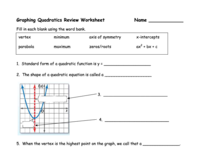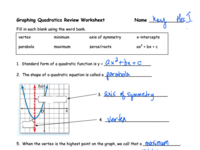Graphing Quadratic Functions - Intercept Form (2)
Directions
1. Complete the Graphing Quadratic Functions Review wksht by recording your answers on separate paper. We will review together in class.
Graphing Quadratics Review
Graphing-Quadratics-Review KEYp1 only
2. Complete the rest of the activities to practice identifying the roots, axis of symmetry, and the vertex.
Creating the Graph
Watch the video to see how the key elements of the parabola help to construct the graph.
How to Graph a Parabola, Vertex, Axis of Symmetry and roots.
Equivalent Statements
We know writing equivalent statements is the key to mathematics. Each statement has a way of revealing a different piece of information. We saw this when we graphed linear functions. Writing an equation in standard form, slope-intercept form, or point-slope form all revealed different key elements of the graph. The same is true for quadratic functions. We will explore how the equivalent forms of a single equation can reveal key elements of the graph.
Let's take a look at how writing this function in factored form can help us find key elements of its graph.
1. Find the zeros of the function using the Zero Product Law.
2. Use that information to type in the correct x-intercepts. Then try to find the axis of symmetry and vertex to reveal the parabola.
Conclusion
Factored form can be very useful in identifying key elements of the graph. Are all quadratic functions factorable though? How do we create the graph if it's not factorable? Can it be graphed? Next week will get into more detailed graphing and explore the answer to these questions.

